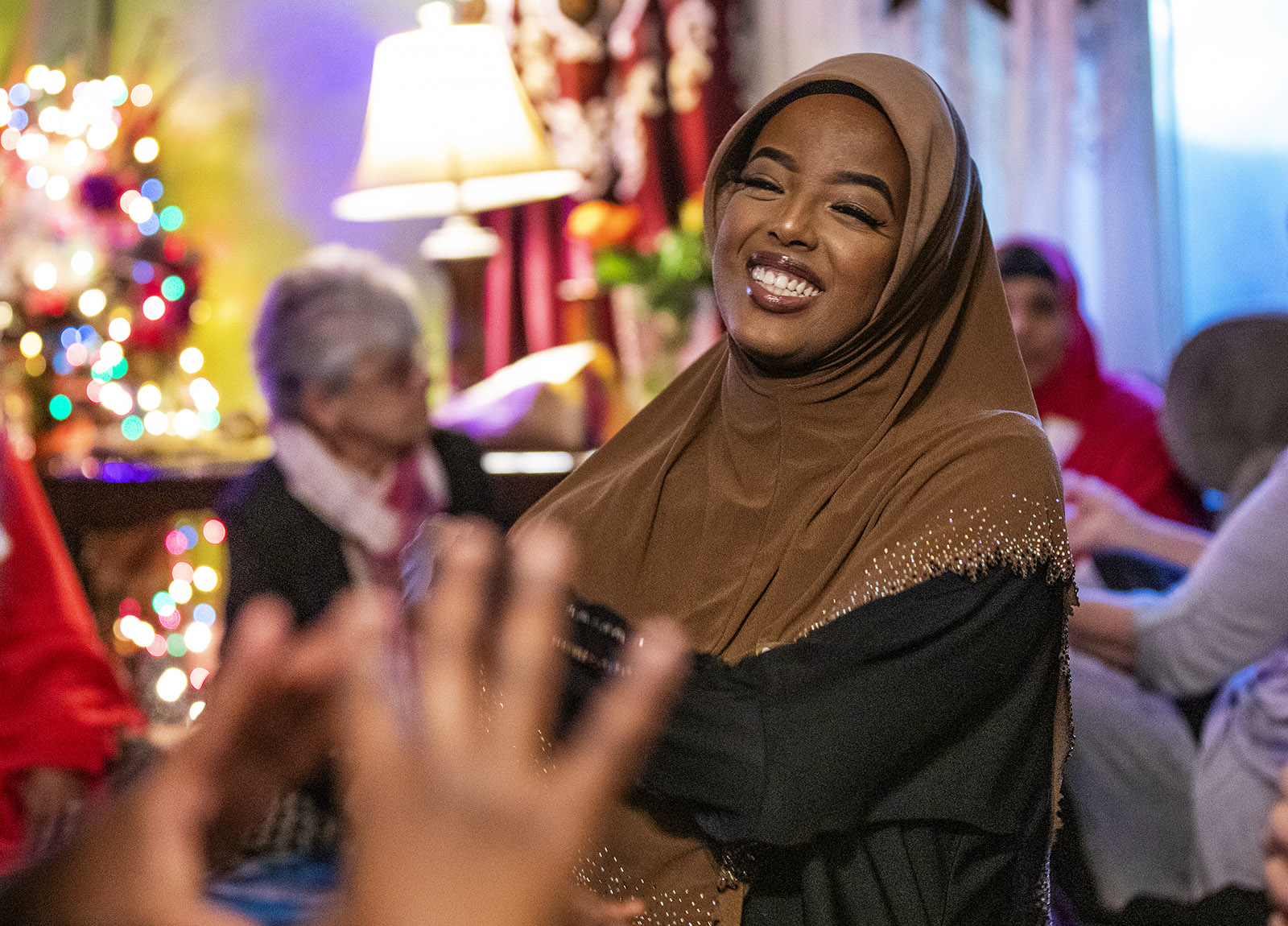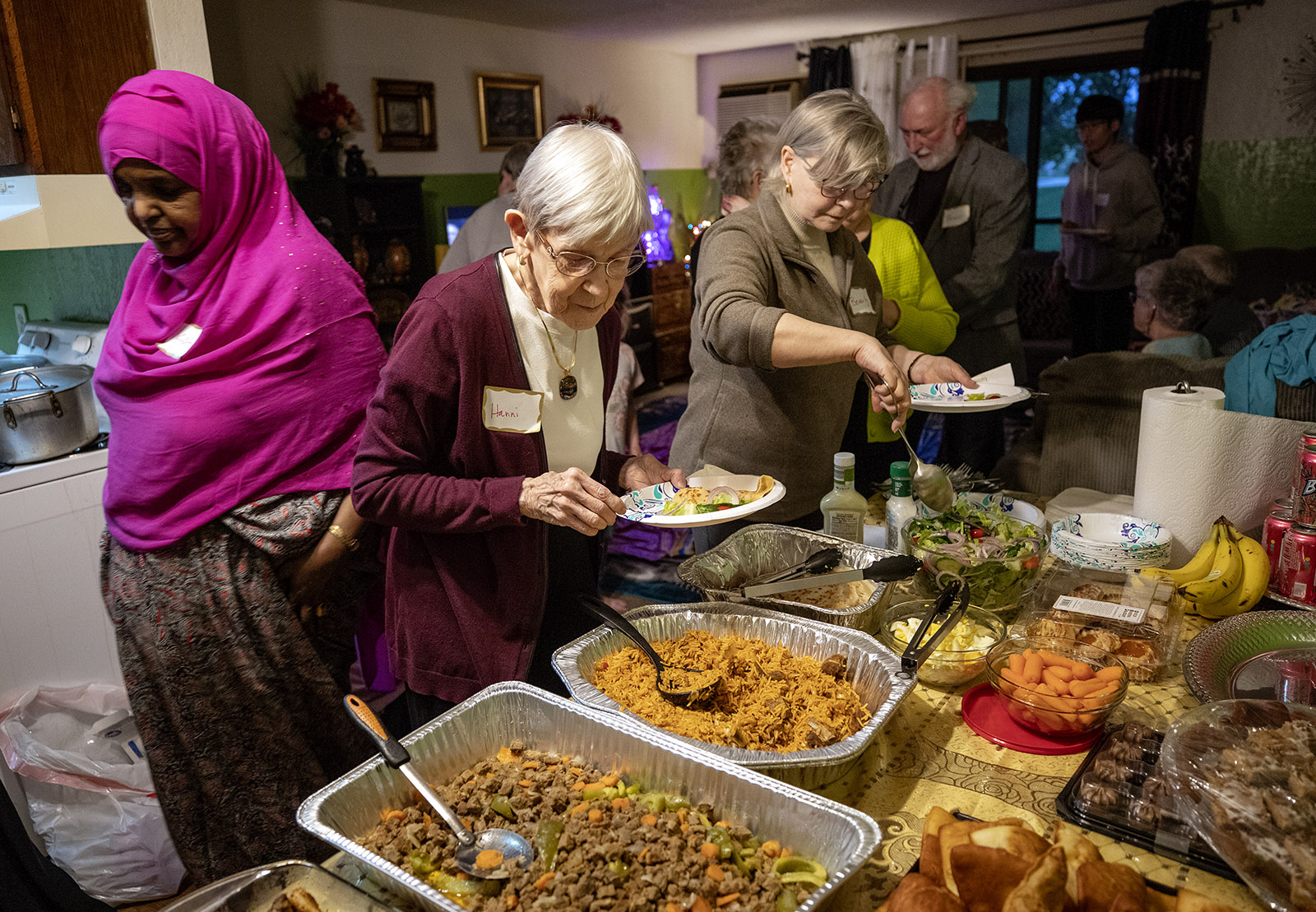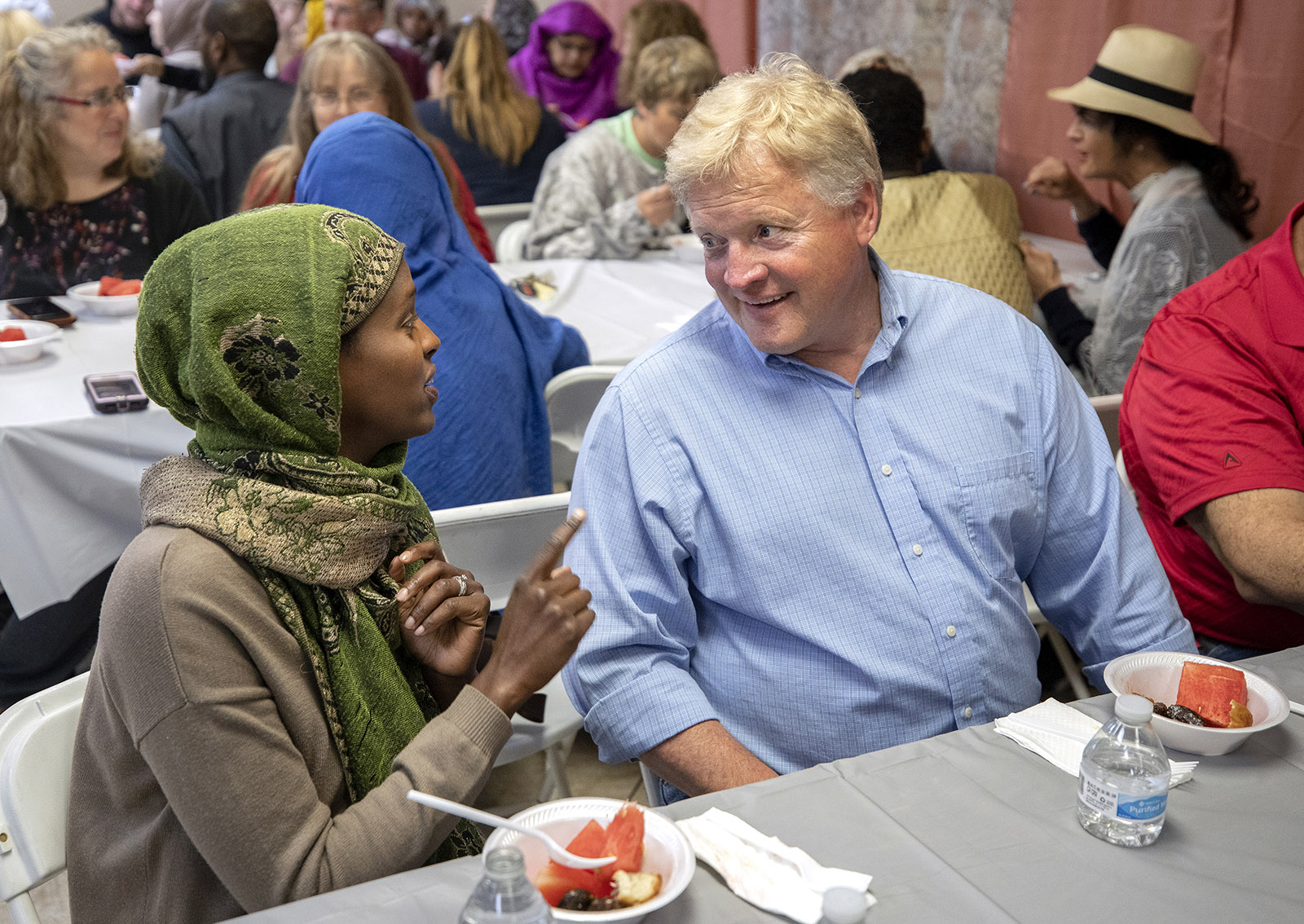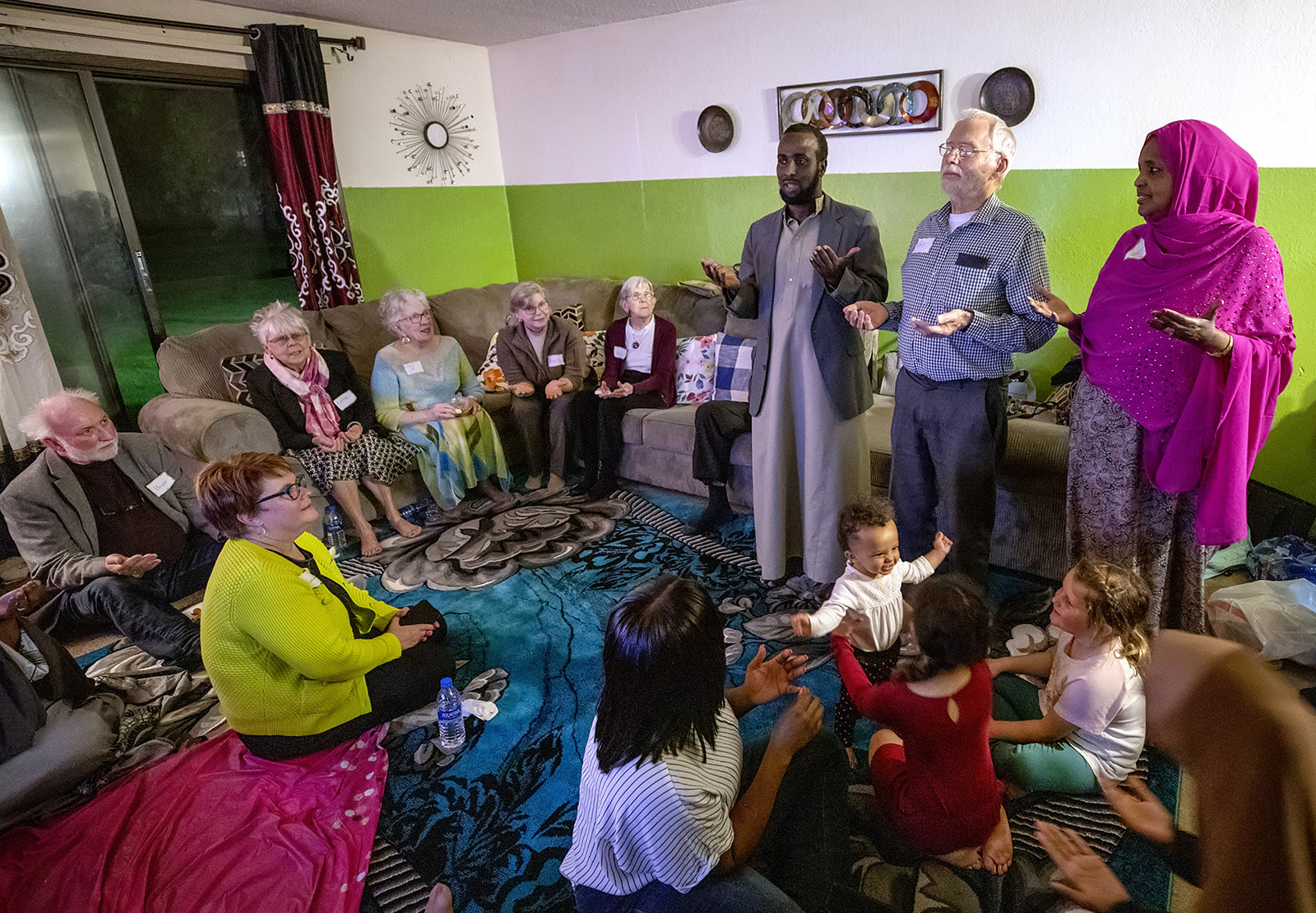Refugees often say that war feels like a wave of violence washing over them, leaving behind death and destruction. The feeling was no different for Katra Ali Hethar, who fled war-torn Somalia in 1991 with her nine small children.
Being responsible for so many lives was a logistical nightmare. But even in moments of emergency, when given the opportunity to hop on a truck or car, she refused to leave a single one behind. She decided that they would either all survive or all perish together, choosing to take turns carrying them on her back. Eventually they made it across the Shebelle River, to the safety of a refugee camp in Kenya.
Two years later, the entire family, including her husband, who had a minor stroke that required immediate medical attention and left Somalia separately, found refuge in America. After living briefly in New York, then some years in Atlanta, the family settled in central Minnesota in 2006. In the nearly three decades since, the mother who survived war and that perilous journey has supported all her children, including three more born since her arrival, into adulthood. The United States offered them a home and security.
Like most migration stories, hers is full of both sadness and hope. Adjusting to life in a new country had its share of struggles. Moving first to St. Cloud, and later to Waite Park, a small town that is virtually a suburb of its larger neighbor, has been another kind of journey for a woman who never worked outside the house but dedicated her life to her children and to her community.
On one of the first warm evenings of this year’s belated spring, I found myself in Ali Hethar’s apartment for a very special event. She had invited a group of people she met at a senior center in St. Cloud, a town where about 80 percent of the population is white and non-Muslim, to share a meal to break the fast during Ramadan and get to know people from different communities better. Most of the guests at her Iftar were her typical neighbors—older white Americans.
The women and men took their shoes off and sat on the floor on a pleasantly soft blue carpet, wearing name tags and exchanging small talk. They conversed with their Somali hosts as, on a muted TV, the Milwaukee Bucks faced the Toronto Raptors in the NBA playoffs. At sunset, they ate dates, drank water, and then enjoyed a Somali meal of meat sambusas, baked goat and rice, with malawax (sweet pancakes) for dessert.
Born in Djibouti, a small East African country on Somalia’s northern border, Ali Hethar is not sure how old she is. Her passport says she was born in 1946, but she believes she was born much later, in 1958—on the last day of Ramadan, in fact. She has never learned English, but as I watched, she greeted, hugged, and smiled at her guests, communicating verbally with translation from of one of her daughters.
There was more to this social gathering than met the eye, for all its easy-going atmosphere. Minnesota, a blue-leaning state, is by many standards exceptionally welcoming of immigrants; it has the country’s second-largest population of Vietnamese Hmong people and is home to more Somalis than any other state in the country. But central Minnesota, where St. Cloud is, about an hour west of Minneapolis, is not such an easy place for outsiders to settle in. It has a strong Catholic tradition and a good many single-issue voters—that issue being abortion. Over 60 percent of voters there went for Trump in 2016.
That year also, though, a young Somali-American named Ilhan Omar beat a longtime Democratic incumbent for a seat in the State House; two years later, she was elected to the US Congress to represent Minnesota’s fifth district (which is centered on Minneapolis). Her election was a testament to how politically engaged the Somali community is. While Omar has gained a high profile on the national stage—both as one of 2018’s intake of Democrats on the strongly progressive wing of the party, and for controversy of over certain of her more combative statements—two other Somali-Americans sit in the Minnesota legislature, with more on the city councils of Minneapolis and St. Paul.
Distinct and notable about St. Cloud’s Somali-American community is that its leaders, elders, and activists have a battle-hardened quality that makes them very effective representatives. So many of them are, in fact, survivors of civil war and brutal dictatorship, that they have become adept at organizing and mobilizing—both in strengthening their own community and in reaching out to other people beyond it.
Advertisement
Established by European settlers in the nineteenth century, it was once referred to as “White Cloud.” But today, this town of 68,000 inhabitants has seen a growing number of Somali refugees arrive in the last two decades to work in meat factories or to attend the local campus of the state university. The presence of these new Muslim residents has created tensions ranging from verbal attacks to school bullying. A walkout by Somali-American high school students in 2015 made national headlines. As did a mall stabbing that year by a Somali immigrant who targeted non-Muslims, an attack that then-candidate Donald Trump exploited in the weeks running up to the presidential election. Within weeks of his election, the Trump administration issued its first Muslim travel ban, which included citizens of Somalia.
As in so many American cities, segregation in housing is also a problem. And even America’s famous constitutional freedom of worship has come up against limits in St. Cloud. A few years ago, the local Islamic Center (itself a mosque) tried to get authorization to build a new mosque in a residential area of downtown St. Cloud. Several hundred people showed up at the city council meeting to advocate for and protest against the project; the proposal ended up being withdrawn.
More recently, a city council member accused the Somali community of trying to enforce Sharia law when it started using a private patrol car for its protection. He later withdrew the charge, but the city forced the community to stop the patrols. Mayor Dave Kleis told me that the decision was purely a matter of observing regulations: the city couldn’t permit private citizens to use cars that looked like police cruisers. He preferred to talk up the positive: “There are a lot of success stories, entrepreneurs, an author of children’s books. We engage, we build, every morning.” Still, many Somalis I spoke to remain upset about the issue of the patrol car because they feel their safety isn’t taken seriously.
“Although Minnesota is a blue state, central Minnesota is a red Bible Belt—and St. Cloud is the buckle,” Bruce Mohs, a longtime resident of St. Cloud, told me at Ali Hethar’s Iftar. “There is some rigidity toward change. I think that some of the tensions are because of the ignorance of the culture.” Mohs did not mean, he was at pains to say, that these white, religious Minnesotans were stupid or bigoted; just unfamiliar with, or uninformed about, the newcomers.
In a section of a report about terrorism recruitment referring to the Somali-American community, the state’s public safety department warned that “a deepening disconnect between youth and religious leaders, an internal identity crisis, community isolation, and lack of opportunity—including high unemployment, lack of activities for youth, and few mentors,” have made some young people vulnerable to radicalization. According to a 2018 report from researchers at George Washington University, between 2013 and 2017, Minnesota’s Twin Cities area was a national hotspot of jihadist mobilization, with seven residents reaching Syria and Iraq, and ten trying unsuccessfully. (Not all of these were Somali-Americans, though in earlier years some two dozen did travel to Somalia to fight for the Islamist group al-Shabab.) This is hardly a tsunami of terrorist recruitment sweeping through the community, but that hasn’t prevented a well-organized network of anti-Muslim groups—such as the Center for Security Policy, ACT for America, and publications such as Creeping Sharia, Jihad Watch, and Refugee Resettlement Watch—from amplifying and promoting public anxiety about the perceived threat.
In spite of bridge-building efforts like Ali Hethar’s, the impact of such fear-mongering is visible in places like St. Cloud—as chronicled in a 2016 episode of public radio’s This American Life. The town’s main mosque is routinely vandalized. Posters carrying anti-refugees messages and hateful comments on the local news sites are all too common. A New York Times news feature on St. Cloud last month focused on the “backlash” facing Somali refugees from “white anti-immigration activists.”
One of my Somali contacts wrote to me of her fears about such coverage—that “in a divided country at this time, are readers being forced to take one side or the other?” And most residents of St. Cloud, whatever their religion or origin, fervently defend their city’s reputation. They say it is a safe place to raise children, with a sound economy and affordable housing. Somalis, who take pride in their entrepreneurial spirit, have revived abandoned shopping centers, selling fabric and all sorts of products for their community. St. Cloud’s State University campus has an increasingly diverse student body, which itself has altered the cultural complexion of the town.
Advertisement
One such exemplar is the woman who had invited me to Ali Hethar’s Iftar, her daughter Ayan Omar. A teacher and activist, she has worked tirelessly for more than a decade to make connections across community divides in St. Cloud, addressing her neighbors’ fears and questions and doing all she can to ease tensions. She’s been teaching for a few years “My Neighbor is a Muslim,” a weeks-long seminar at the Sacred Heart Church and routinely holds race sensitivity trainings. She recently received an Outstanding Refugee award from the Minnesota Department of Human Services for her civic duties.
“My religion is very important to me,” she told me. “It’s 90 percent of my identity; it’s who I am, how I live my life. I try to get people to understand that who I am, and what my religion is, conflicts very much with what they get in the news, what’s perpetuated online, what the president perpetuates when he says Islam hates us.”
Abdi Daisane, the owner of a daycare center and also an active member of the community, was my guide during my visit. He took me on tours of the town, meeting with community leaders, entrepreneurs, and religious figures. He told me that when he ran for city council in 2016, people mostly had questions about Islam. And he was happy to address their concerns. He was not elected, though intends to try again in future. (The body presently comprises six men and one woman, all of them white.)
“It’s a beautiful community” was his first response when I asked him if it were true that St. Cloud was “the worst place in Minnesota to be a Somali,” as a Twin Cities magazine declared in 2016. “There is a very small group of people giving us hell in some situations,” he added, “but the majority of people are welcoming. There are people ‘in the center’ that don’t talk. They don’t harm or support us.”
We visited a friend of Daisane’s, Ahmed Ali, in his small office where he works as an accountant. Sitting at his desk, with certificates for three graduate degrees displayed on the wall behind him, where American and Somali flags were also hung, Ali echoed the feeling that the truth is somewhere between the extremes of intolerance and harmony. “There are two St. Clouds,” he said. “The negative St. Cloud gets more coverage than the positive St. Cloud.”
Ali is also very politically engaged. “We are political animals,” he told me of the Somali community, pointing to a photo of him on the wall in which he was protesting on Trump’s inauguration day. He said he was more concerned for women than for himself because their religious orientation is visibly apparent.
“Somali women wear hijab, easier for anyone to identify them,” he said. “Once a woman pointed to my wife and told her, ‘You don’t have to wear that on your head. This is America, it’s a free country.’” Ali told me they just thanked the woman and drove away.
Naima Hussein, who moved here in 2010 to pursue a degree in psychology at St. Cloud State University, also experienced bigotry from a stranger when she was working at Walmart some years ago. “A man told me, ‘If I had a gun right now, I would shoot you,’” she recalled. “I had my back turned and I said ‘Thank you.’ I didn’t know how else to respond.”
As I watched people park and head inside the Islamic Center that night for another Iftar, I couldn’t help thinking of the victims of the recent attack in Christchurch, New Zealand. I asked Mohayadin Mohamed, the center’s president, if he and his colleagues had taken any special measures. “We are vigilant,” he assured me. In what used to be an elementary school and a church, people took off their shoes and sat on chairs inside the prayer hall. As at Ali Hethar’s Iftar, food was central to the evening, and non-Muslim guests were welcomed; before breaking the fast, several members of the community shared words about Islam, listened to the reading of the Qur’an, and then moved to a different room to begin mingling and eating.
This kind of cross-cultural, interdenominational event is increasingly common and popular in St. Cloud. One of this Iftar’s organizers was a white resident, Natalie Ringsmuth, who grew up in the city and has seen it become more diverse. She is the founder and director of #unitecloud, a nonprofit working to reduce racial, religious, and cultural tensions in Central Minnesota.
“At this point, this is who we are,” she said. “We’re not going to be anything but a diverse city. Some people just can’t swallow it. I wish that we were farther along than we are, but I am grateful that we are moving the needle together as a community.”
For some Somalis, too, traditions are very important. On a Saturday morning, I visited a Qur’anic school in downtown St. Cloud. Girls and boys, some dressed in traditional clothes, come on the weekends to work on their religious education. In one of the classes, about twenty-five boys recited the Qur’an in unison. Even if they don’t speak Arabic, they have learned how to read the religious text and are taught the fundamentals of Islam.
“We teach them how to be better persons in the future. So that they don’t forget [who they are],” their teacher, Hassan Shuriye, told me.
Back at Ali Hethar’s apartment in Waite Park on the evening of the Iftar, Ayan Omar’s ten-month-old baby was sitting on the floor, the center of attention, while her other daughter ran around cheerfully. “My daughter didn’t understand that I was a teacher because all the teachers at her school were white,” Omar told me. She is trying hard to transmit to her daughters a strong sense of purpose. She has been reading Michelle Obama’s autobiography with her older daughter to set an example for her.
At the end of the meal, a close Somali friend of the family’s and one of the guests, a retired Catholic priest, read two prayers, one in Arabic and another in English. The group, their palms raised upward, ended in unison—some saying “Amen,” others “Amine.”
This report was produced with support from the Round Earth Media program of the International Women’s Media Foundation.





